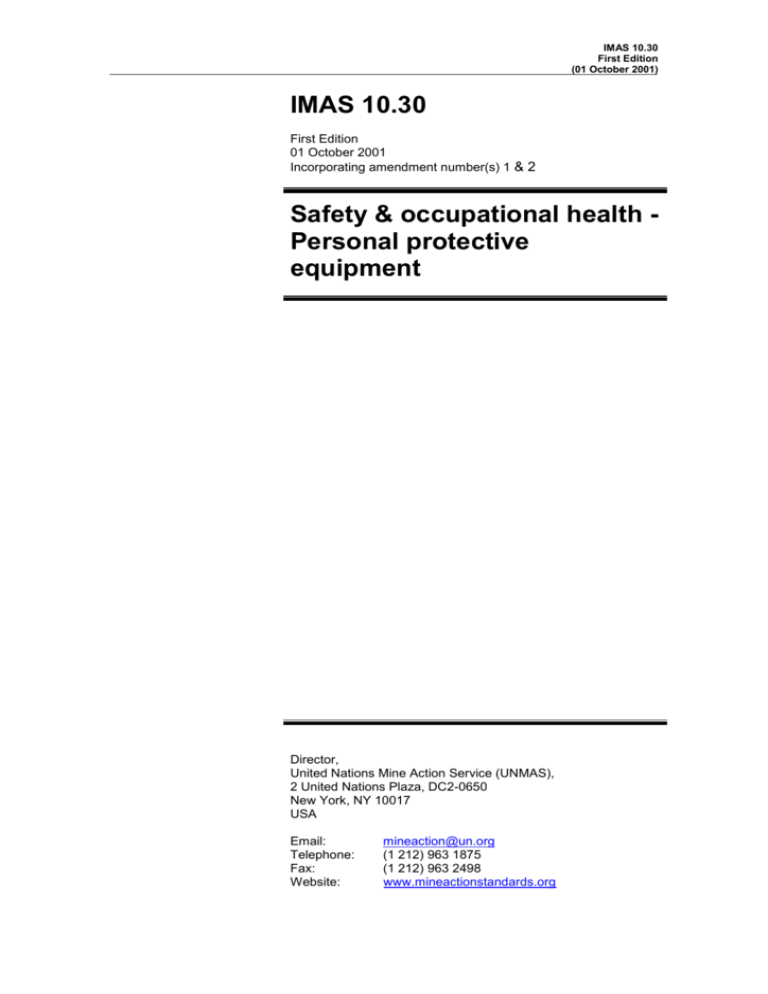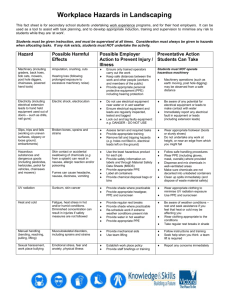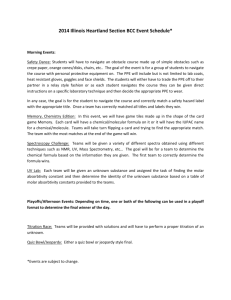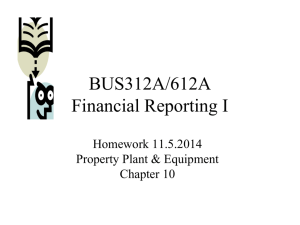
IMAS 10.30
First Edition
(01 October 2001)
IMAS 10.30
First Edition
01 October 2001
Incorporating amendment number(s) 1 & 2
Safety & occupational health Personal protective
equipment
Director,
United Nations Mine Action Service (UNMAS),
2 United Nations Plaza, DC2-0650
New York, NY 10017
USA
Email:
Telephone:
Fax:
Website:
mineaction@un.org
(1 212) 963 1875
(1 212) 963 2498
www.mineactionstandards.org
IMAS 10.30
First Edition
(01 October 2001)
Warning
This document is current with effect from the date shown on the cover page. As the
International Mine Action Standards (IMAS) are subject to regular review and revision,
users should consult the IMAS project website in order to verify its status at
(http://www.mineactionstandards.org/, or through the UNMAS website at
http://www.mineaction.org)
Copyright notice
This UN document is an International Mine Action Standard (IMAS) and is copyright
protected by the UN. Neither this document, nor any extract from it, may be
reproduced, stored or transmitted in any form, or by any means, for any other purpose
without prior written permission from UNMAS, acting on behalf of the UN.
This document is not to be sold.
Director
United Nations Mine Action Service (UNMAS)
2 United Nations Plaza, DC2-0650
New York, NY 10017
USA
Email:
Telephone:
Fax:
mineaction@un.org
(1 212) 963 1875
(1 212) 963 2498
UNMAS 2001 – All rights reserved
ii
IMAS 10.30
First Edition
(01 October 2001)
Contents
Contents ........................................................................................................................................ iii
Foreword ....................................................................................................................................... iv
Introduction .....................................................................................................................................v
Safety & occupational health - Personal protective equipment..................................................... 1
1.
Scope .................................................................................................................................. 1
2.
References .......................................................................................................................... 1
3.
Terms, definitions and abbreviations .................................................................................. 1
4.
Personal Protective Equipment (PPE) requirements .......................................................... 2
4.1.
General .......................................................................................................................... 2
4.2.
Blast protection .............................................................................................................. 2
4.3.
Fragmentation protection ............................................................................................... 3
4.4.
Explosive Ordnance Disposal (EOD) operations ........................................................... 3
5.
Responsibilities ................................................................................................................... 3
5.1.
General requirements .................................................................................................... 3
5.2.
National Mine Action Authority (NMAA) ......................................................................... 3
5.3.
Demining organisations ................................................................................................. 4
5.4.
Demining employees ..................................................................................................... 4
Annex A (Normative) References.................................................................................................. 5
Annex B (Informative) Terms, definitions and abbreviations ........................................................ 6
Amendment record ........................................................................................................................ 8
iii
IMAS 10.30
First Edition
(01 October 2001)
Foreword
International standards for humanitarian demining programmes were first proposed by working
groups at an international technical conference in Denmark, in July 1996. Criteria were
prescribed for all aspects of demining, standards were recommended and a new universal
definition of ‘clearance’ was agreed. In late 1996, the principles proposed in Denmark were
developed by a UN-led working group and the International Standards for Humanitarian Mine
Clearance Operations were developed. A first edition was issued by the UN Mine Action
Service (UNMAS) in March 1997.
The scope of these original standards has since been expanded to include the other
components of mine action and to reflect changes to operational procedures, practices and
norms. The standards were re-developed and renamed as International Mine Action
Standards (IMAS) with the first edition produced in October 2001.
The United Nations has a general responsibility for enabling and encouraging the effective
management of mine action programmes, including the development and maintenance of
standards. UNMAS, therefore, is the office within the United Nations responsible for the
development and maintenance of IMAS. IMAS are produced with the assistance of the
Geneva International Centre for Humanitarian Demining.
The work of preparing, reviewing and revising IMAS is conducted by technical committees,
with the support of international, governmental and non-governmental organisations. The
latest version of each standard, together with information on the work of the technical
committees, can be found at http://www.mineactionstandards.org/. Individual IMAS are
reviewed at least every three years to reflect developing mine action norms and practices and
to incorporate changes to international regulations and requirements.
iv
IMAS 10.30
First Edition
(01 October 2001)
Introduction
The needs to reduce risk and to provide a safe working environment are fundamental
principles of mine action management (see IMAS 10.10). Risk reduction involves a
combination of safe working practices and operating procedures, effective supervision and
control, appropriate education and training, equipment of inherently safe design, and the
provision of effective Personal Protective Equipment (PPE) and clothing.
As a minimum, all employees involved in demining should be provided with comfortable and
serviceable clothing and footwear appropriate to the task and local conditions.
PPE should be regarded as a 'last resort' to protect against the effects of mine and Explosive
Remnants of War (ERW) hazards. It should be the final protective measure after all planning,
training and procedural efforts to reduce risk have been taken. There are a number of reasons
for this approach. First, PPE protects only the person wearing it, whereas measures
controlling the risk at source can protect everyone at the demining workplace. Second,
theoretical maximum levels of protection are seldom achieved with PPE in practice, and the
actual level of protection is difficult to assess; effective protection is only achieved by suitable
PPE, correctly fitted, and properly maintained and used. And third, PPE may restrict the
wearer to some extent by limiting mobility or visibility, or by requiring additional weight to be
carried.
The risk to deminers comes principally from Anti Personnel (AP) blast mines, AP
fragmentation mines, Anti Tank (AT) mines and UXO. AP blast mines are the most abundant
mines encountered in humanitarian demining and cause the greatest number of injuries. At
close quarters, AP fragmentation mines and AT mines overmatch PPE currently available.
Due to the area effect of such mines they also have the potential to cause 'secondary victims'.
When ERW (UXO and AXO) (see definitions in Annex B) are encountered in humanitarian
demining, they are usually high in metal content, on or near the surface, and constitute less of
a hazard than mines. The varied nature of ERW means that these hazards are best dealt with
procedurally rather than relying on PPE designed primarily for humanitarian demining.
v
IMAS 10.30
First Edition
(01 October 2001)
Safety & occupational health - Personal protective equipment
1.
Scope
This IMAS provides specifications and guidance to National Mine Action Authorities (NMAA)
and demining organisations on the minimum requirements of Personal Protective Equipment
(PPE), including protective clothing, for use in mine action.
It does not provide guidance on the design characteristics of PPE garments, or on test and
evaluation procedures. General requirements for PPE are included in ISO/DIS14876-1:
1999(E).
2.
References
A list of normative references is given in Annex A. Normative references are important
documents to which reference is made in this standard and which form part of the provisions of
this standard.
3.
Terms, definitions and abbreviations
A list of terms, definitions and abbreviations used in this standard is given in Annex B. A
complete glossary of all the terms, definitions and abbreviations used in the IMAS series of
standards is given in IMAS 04.10.
In the IMAS series of standards, the words 'shall', 'should' and 'may' are used to indicate the
intended degree of compliance. This use is consistent with the language used in ISO
standards and guidelines:
a)
'shall' is used to indicate requirements, methods or specifications that are to be
applied in order to conform to the standard;
b)
'should' is used to indicate the preferred requirements, methods or specifications;
and
c)
'may' is used to indicate a possible method or course of action.
The term 'National Mine Action Authority (NMAA)' refers to the government department(s),
organisation(s) or institution(s) in each mine-affected country charged with the regulation,
management and co-ordination of mine action. In most cases the national Mine Action Centre
(MAC) or its equivalent will act as, or on behalf of, the 'NMAA'.
The term 'employer' refers to any organisation (government, NGO or commercial entity)
responsible for implementing demining projects or tasks. The employer may be a prime
contractor, subcontractor, consultant or agent.
The term 'employee' refers to people who work for an employer. Employees may be involved
in management, operational or support activities.
The term 'Personal Protective Equipment (PPE)’ refers to all equipment and clothing designed
to provide protection, which is intended to be worn or held by a employee at work and which
protects him/her against one or more risks to his/her safety or health.
1
IMAS 10.30
First Edition
(01 October 2001)
4.
Personal Protective Equipment (PPE) requirements
4.1.
General
The levels of PPE provided for use in hazardous areas shall be based on a number of factors
including: the local risk(s), operational procedures and practices, and local environmental
conditions. (Guidelines on the process of risk assessment and risk reduction are given in ISO
Guide 51.)
Training shall be provided on the proper use, maintenance and storage of the PPE in use
within the demining organisation. Facilities should be provided for its proper storage, carriage,
cleaning and maintenance. Equipment shall be examined on a regular basis to ensure that it
is suitable for use.
4.2.
Blast protection
PPE should be capable of protecting against the blast effects of 240 gm of TNT at stand-off
distances, for each item of PPE, appropriate to the activity performed in accordance with
SOPs. Equipment provided to reduce the risk from such a hazard shall include, as a
minimum:
a)
frontal protection, appropriate to the activity, capable of protecting against the blast
effects of 240 gm of TNT at 30 cm from the closest part of the body; and
b)
eye protection capable of retaining integrity against the blast effects of 240 gm of
TNT at 60 cm, providing full frontal coverage of face and throat as part of the
specified frontal protection ensemble.
Note:
A Technical Note for Mine Action (TNMA) will be developed to lay down the Test and
Evaluation (T&E) protocols to be followed during the test regime of PPE.
Note:
Although this standard lays down distances at which the PPE must be effective it must be
emphasised that this does NOT imply to deminers that they will be safe at such distances.
Distance itself is an excellent attenuator of blast effects and the further away from an
undesired explosive event the better!
The frontal protection ensemble provided to employees, whether required to kneel, sit or squat
shall be designed to cover the eyes, throat (frontal neck), chest, abdomen and genitals.
Where SOPs permit employees to work in the kneeling or squatting position, the frontal
protection ensemble should cover the front of the thighs.
Note:
There should be no gaps between separate items of PPE. This specifically concerns visors
that project below the face and overlap the upper body PPE but still leave a vertical gap
where blast debris can enter and cause damage to the face and eyes.
Hand tools should be constructed in such a way that their separation or fragmentation resulting
from the detonation of an AP blast-mine incident is reduced to a minimum. They should be
used with appropriate hand protection such as a hand-shield or gloves. Hand tools should be
designed to be used at a low angle to the ground and should provide adequate stand-off from
an anticipated point of detonation.
During the risk reduction process, demining organisations may consider providing blast proof
boots for the protection of feet and lower limbs, where there is a significant risk that cannot be
reduced by SOPs alone, provided that the blast boots being considered are proven to be
effective in reducing that risk.
2
IMAS 10.30
First Edition
(01 October 2001)
Note:
The effectiveness and operational benefits of mine boots is still a contentious issue within the
mine clearance community, and there are wide ranging views and opinions on their use.
Nevertheless mine boots do exist, and therefore demining organizations may wish to
evaluate their suitability for their particular operational scenario during the planning phase of
a clearance operation. To date, only one independent trial (US State Department sponsored)
has been conducted, which identified that the cost of provision and replacement is high,
whilst the benefits are unproven. There is currently a danger that they offer ‘false security’.
The situation will be monitored and reviewed during the ongoing review process for IMAS,
and any updates will be distributed through TNMA.
4.3.
Fragmentation protection
Fragmentation mines currently overmatch all but specialist EOD ensembles, which
emphasises the initial need to minimise risk procedurally via appropriate SOPs. Protection
should nevertheless be provided against non-designed fragmentation from other mines, (such
as that from plastic-bodied blast mines), and to potential secondary victims where such a risk
cannot be removed procedurally. PPE provided to reduce the risk from such a hazard should
include, as a minimum:
a)
ballistic body armour with a STANAG 2920 V50 rating (dry) of 450m/s for 1.102g
fragments. (Such tests for ballistic protection do not realistically replicate mine
effects, but will continue to be used until an accepted alternative is developed as an
international standard); and
b)
a full face visor as described in clause 4.2(b) above. However, if an analysis of the
risk using the criteria set out in these guidelines and IMAS 01.10 indicates that a full
face visor would provide inadequate protection across a full 3600 spectrum, then a
helmet should be worn. The helmet should have a ballistic rating similar to the
ballistic body armour selected by the demining organization.
Note:
Eye protection should be no less than that offered by 5mm of untreated polycarbonate. It
should provide full frontal coverage of face and throat as part of the specified frontal
protection ensemble. (If the body protection is fitted with an ‘overlap’, then the visor should
be capable of fitting behind this ‘overlap’ when in use).
Note:
A TNMA will be developed to lay down the T&E protocols to be followed during the test
regime of PPE.
4.4.
Explosive Ordnance Disposal (EOD) operations
When engaged in the clearance of ERW, an enhanced level of protection may be necessary.
This should be defined in Standard Operating Procedures (SOPs), and may include
conventional body armour or other specialist PPE ensembles.
5.
Responsibilities
5.1.
General requirements
NMAA and employers (governments, NGOs and commercial entities) shall establish and
maintain policy, standards and guidelines on the minimum requirements of PPE for use in
national mine action programmes. This should distinguish between the obligations and
responsibilities at the national level, and those of the employer and employee as set out below.
5.2.
National Mine Action Authority (NMAA)
The NMAA shall:
a)
establish and maintain national standards to be applied for PPE;
b)
monitor the application of standards; and
3
IMAS 10.30
First Edition
(01 October 2001)
c)
undertake periodic reviews of the national standards for PPE and the technologies
available to reduce risks.
5.3.
Demining organisations
Demining organisations shall:
a)
apply the documented NMAA standards for PPE;
b)
meet, or exceed, the minimum requirements for the provision of PPE. In this
regard, provide PPE to employees which is serviceable and appropriate to the risk,
local operational procedures and environmental conditions;
c)
provide training and supervision in the correct use and maintenance of PPE;
d)
establish and maintain SOPs that specify care and maintenance requirements;
e)
provide suitable facilities for the storage, carriage, cleaning and maintenance of
PPE; and
f)
establish and maintain documented SOPs to undertake periodic reviews of PPE.
In the absence of a NMAA or authorities, the demining organisation should assume additional
responsibilities. These include, but are not restricted to:
a)
issue, maintain and update their own standards to be applied for PPE;
b)
cooperate with other employers in the same country to ensure consistency of
standards of use and maintenance of PPE; and
c)
assist the host nation, during the establishment of a NMAA, in framing national
standards for PPE.
5.4.
Demining employees
Employees of demining organisations shall:
a)
use PPE in accordance with the requirements specified by their employers and the
manufacturer's specification for the PPE, including the use of facilities provided for
storage and carriage of PPE;
b)
clean and maintain the PPE in accordance with the demining organisation's SOPs
and/or the manufacturer's specifications or guidelines; and
c)
report to the employer, problems with the equipment or suggested improvements to
SOP, which may reduce the requirement for PPE, or improvements in the design or
application of PPE.
4
IMAS 10.30
First Edition
(01 October 2001)
Annex A
(Normative)
References
The following normative documents contain provisions, which, through reference in this text,
constitute provisions of this part of the standard. For dated references, subsequent
amendments to, or revisions of, any of these publications do not apply. However, parties to
agreements based on this part of the standard are encouraged to investigate the possibility of
applying the most recent editions of the normative documents indicated below. For undated
references, the latest edition of the normative document referred to applies. Members of ISO
and IEC maintain registers of currently valid ISO or EN:
a)
ISO Guide 51 Safety aspects – Guidelines for their inclusion in standards;
b)
ISO/DIS 14876-1:1999 (E) Protective clothing – Body armour – Part 1: General
requirements;
c)
IMAS 01.10 Guide to the application of IMAS;
d)
IMAS 04.10 Glossary of mine action terms, definitions and abbreviations;
e)
IMAS 10.10 S&OH - General requirements; and
f)
STANAG 2920.
The latest version/edition of these references should be used. GICHD hold copies of all
references used in this standard. A register of the latest version/edition of the IMAS
standards, guides and references is maintained by GICHD, and can be read on the IMAS
website: (See www.mineactionstandards.org). NMAA, employers and other interested bodies
and organisations should obtain copies before commencing mine action programmes.
5
IMAS 10.30
First Edition
(01 October 2001)
Annex B
(Informative)
Terms, definitions and abbreviations
B.1.
Abandoned Explosive Ordnance (AXO)
explosive ordnance that has not been used during an armed conflict, that has been left behind
or dumped by a party to an armed conflict, and which is no longer under control of the party
that left it behind or dumped it. Abandoned explosive ordnance may or may not have been
primed, fuzed, armed or otherwise prepared for use. (CCW protocol V)
B.2.
accident
an undesired event which results in harm.
Note:
Modified from definition in OHSAS 18001:1999.
B.3.
demining accident
an accident at a demining workplace involving a mine or ERW hazard (c.f. mine accident).
B.4.
demining incident
an incident at a demining workplace involving a mine or ERW hazard (c.f. mine incident).
B.5.
demining worker
all employees who work at a demining worksite.
B.6.
demining worksite
any workplace where demining activities are undertaken.
Note:
Demining worksites includes workplaces where survey, clearance and EOD activities are
undertaken including centralised disposal sites used for the destruction of mines and ERW
identified and removed during clearance operations.
Note:
Survey, in relation to a demining worksite includes general survey undertaken to identify
mine and ERW hazards and hazardous areas.
B.7.
ensemble
the group of protective clothing designed to be worn as a protective measure.
B.8.
Explosive Remnants of War (ERW)
Unexploded Ordnance (UXO) and Abandoned Explosive Ordnance (AXO). (CCW protocol V).
B.9.
incident
an event that gives rise to an accident or has the potential to lead to an accident.
B.10.
mine accident
an accident away from the demining workplace involving a mine or ERW hazard (c.f. demining
accident).
6
IMAS 10.30
First Edition
(01 October 2001)
B.11.
mine incident
an incident away from the demining workplace involving a mine or ERW hazard (c.f. demining
incident).
B.12.
Personal Protective Equipment (PPE)
all equipment and clothing designed to provide protection, which is intended to be worn or held
by an employee at work and which protects him/her against one or more risks to his/her safety
or health.
B.13.
protective measure
means used to reduce risk. [ISO Guide 51:1999(E)]
B.14.
risk
combination of the probability of occurrence of harm and the severity of that harm. [ISO Guide
51:1999(E)]
B.15.
Unexploded Ordnance (UXO)
EO that has been primed, fuzed, armed or otherwise prepared for use or used. It may have
been fired, dropped, launched or projected yet remains unexploded either through malfunction
or design or for any other reason.
B.16.
workplace
all places where workers need to be or to go by reason of their work and which are under the
direct or indirect control of the employer. [ILO R164]
7
IMAS 10.30
First Edition
(01 October 2001)
Amendment record
Management of IMAS amendments
The IMAS series of standards are subject to formal review on a three-yearly basis, however
this does not preclude amendments being made within these three-year periods for reasons of
operational safety and efficiency or for editorial purposes.
As amendments are made to this IMAS they will be given a number, and the date and general
details of the amendment shown in the table below. The amendment will also be shown on
the cover page of the IMAS by the inclusion under the edition date of the phrase ‘incorporating
amendment number(s) 1 etc.’
As the formal reviews of each IMAS are completed new editions may be issued. Amendments
up to the date of the new edition will be incorporated into the new edition and the amendment
record table cleared. Recording of amendments will then start again until a further review is
carried out.
The most recently amended IMAS will be the versions that are posted on the IMAS website at
www.mineactionstandards.org.
Number
1
2
Date
1 Dec 2004
Amendment Details
1. Formatting changes.
2. Minor text editing changes.
3. Changes to terms, definitions and abbreviations where necessary to ensure that this
IMAS is consistent with IMAS 04.10.
1. Minor changes/additions to the first and second paragraph of the foreword.
2. Introduction, changes to last paragraph.
3. Inclusion of the term ‘mines and ERW’ and ‘AXO’.
4. Removal of the term ‘threat’ from throughout the IMAS.
8




